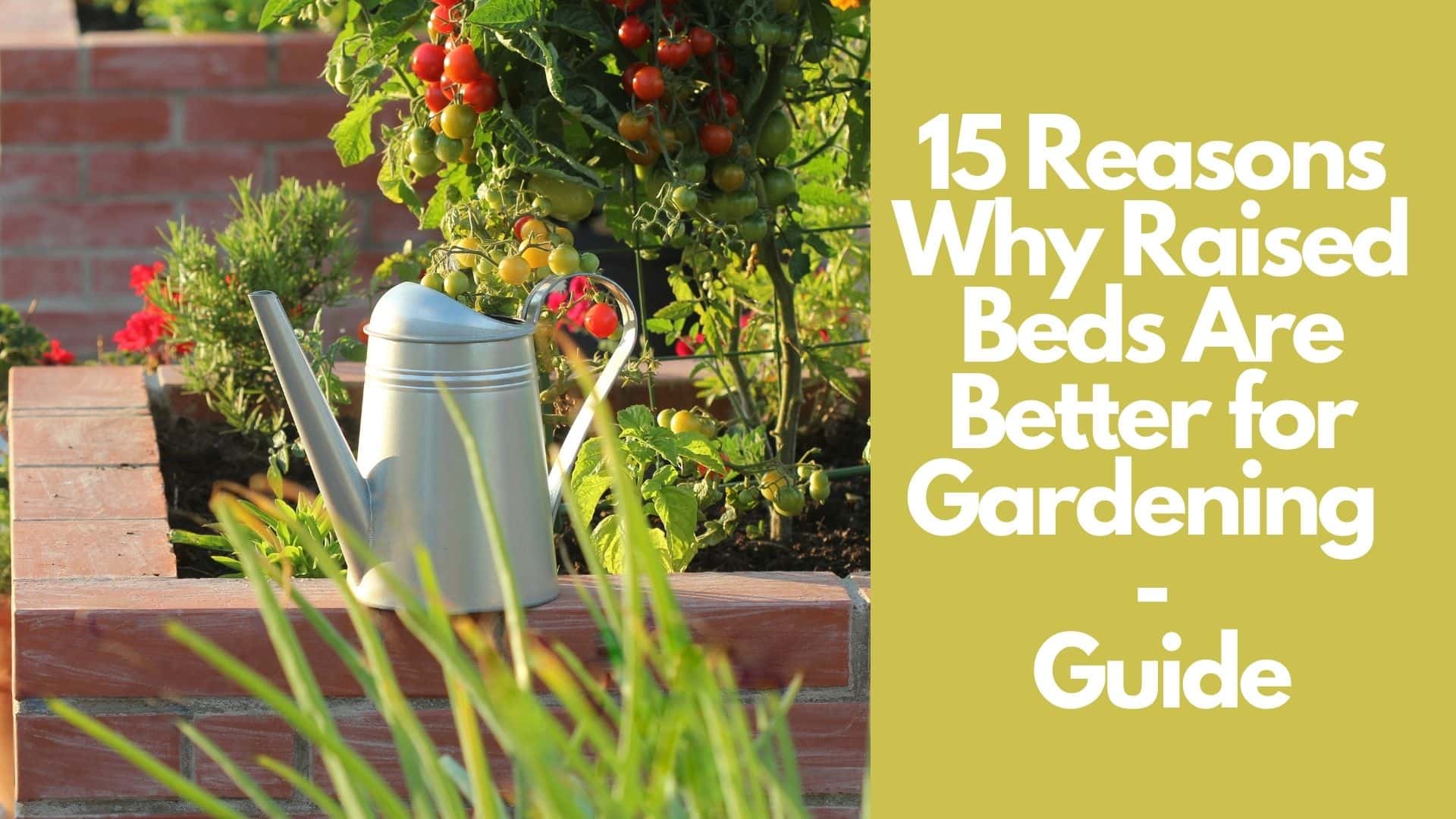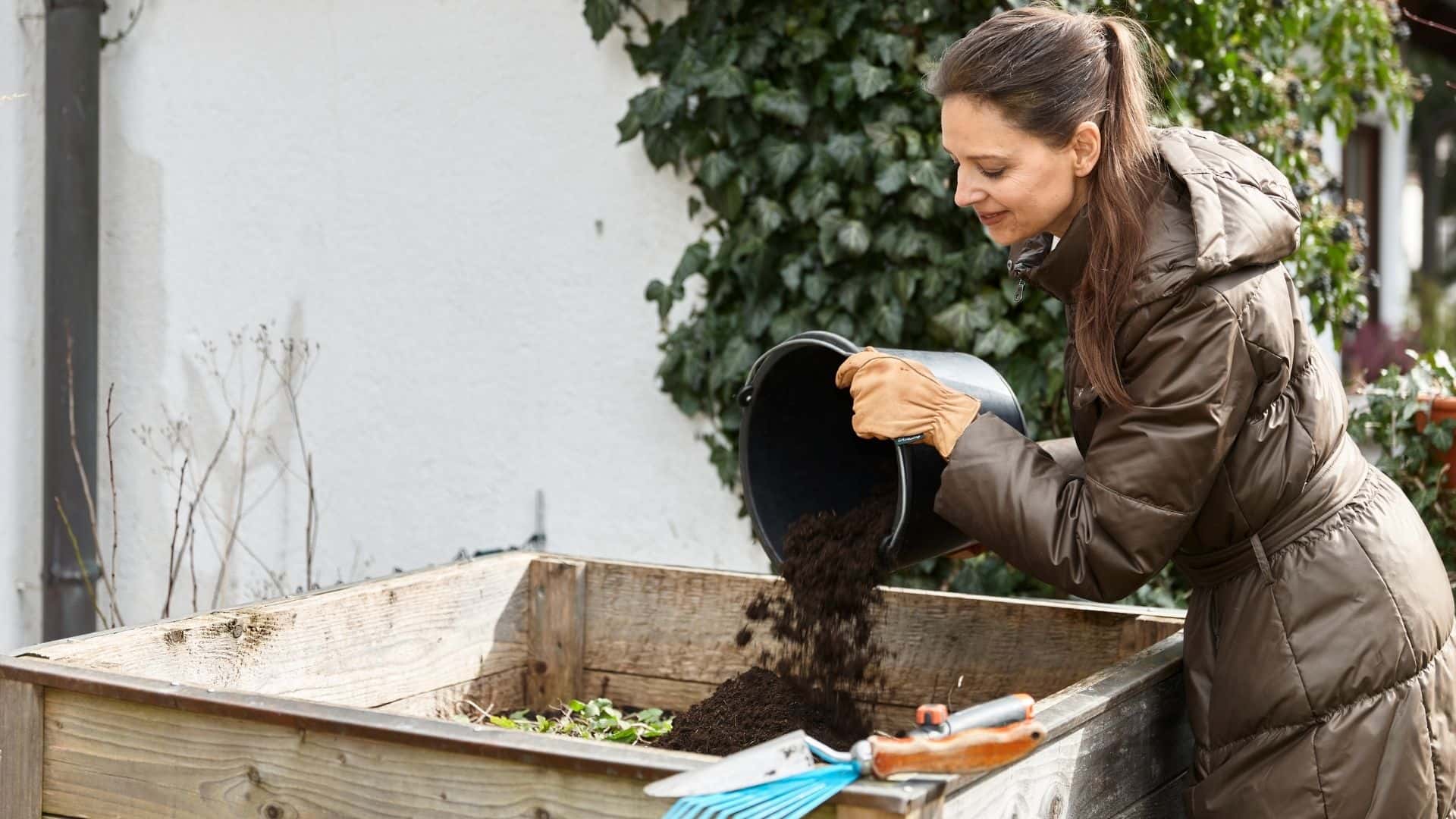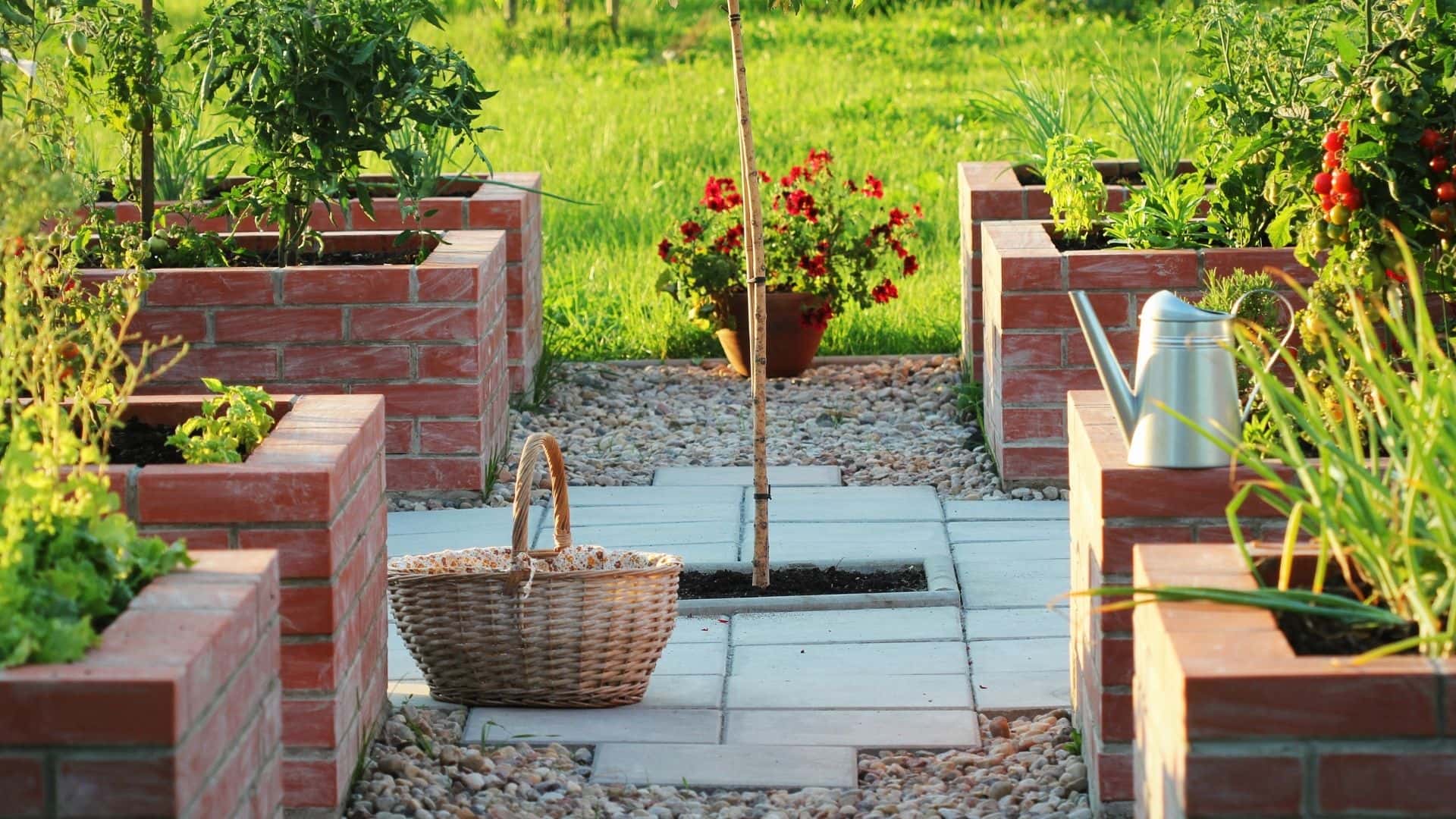Wondering why use raised beds in your garden? Discover 15 excellent reasons that show how raised beds can improve soil, boost growth, and make gardening easier. In gardening, raised beds are defined as a garden bed that is elevated above the ground rather than sunk into the ground to address a variety of gardening issues. Raised beds can be made by simply piling soil on top of one another or by using boxes to confine and contain garden soil in a specific area.
You can create a raised bed frame out of wood, stone, or any other type of material. Gardeners who use raised beds can choose from a variety of sizes and shapes to suit their needs.
Raised beds have grown in popularity recently, with a growing number of gardeners opting for them. Raised garden beds provide many benefits. By reading this guide, you will be able to know, 15 Excellent Reasons to Use Raised Beds in Your Garden.

Let’s start,
Why use raised beds in your garden?
Raised beds are now widely used by gardeners for their gardening. Because that gardening is so close to them. There are so many reasons for this. This will be discussed below.
1. Raised beds have a more aesthetically pleasing appearance
Raised beds offer visual interest to a garden. The aesthetic value adds a lot to the worth of the house.
You can use a variety of planter boxes in varying sizes, heights, and shapes to come up with a unique garden design. Even when bare, wooden planter boxes have a rustic charm that makes them attractive in and of themselves.
A raised bed may be a must in the city if you want to keep your neighbors pleased with a front yard food garden. The distinct border between the bed and the walkway is another benefit of raised beds, they make pathways easier to maintain.
2. More effective drainage of the soil
Raised beds aid in greater drainage of the soil. Soil that is loamy or crumbly has a higher water-holding capacity. Raised beds have looser soil because they are never trampled on, and looser soil drains better.
Almost a foot of extra breathing space above wet conditions is sufficient drainage for most crops. Raised beds tend to drain more efficiently, especially during heavy rain.
3. Easy to keep the garden out of pests
Raised beds allow you to better monitor pest problems because the plants are at eye level. Elevated garden boxes restrict the progress of slugs, which can be used to your advantage by trapping them as they try to scale up the tall edges of the box. Copper flashing, which can border your box, is said by many gardeners to be impenetrable to slugs.
You can add hardware cloth to the bottom of the box will keep crawling pests like groundhogs from grabbing your root vegetables.
Setting up cheap and easy DIY trellis-like chicken wires that also serve as a fence to your raised beds will help keep your pets out of them.
Dogs are less likely to urinate on your plants because of their height. If deer are an issue, you can buy a box with a built-in deer fence or add deer fencing directly to your bed.
Raised garden beds make it much easier to add bird barriers, cold frames, and row covers like plastic hoops.
4. Prevention of soil compaction
The protection raised beds to provide against foot traffic particularly that of youngsters working in a garden area is one of their most significant advantages.
Soil is not compacted and plants are less likely to be injured because people labor on walkways rather than raised beds.
5. Less weeding
Raised beds that are well-maintained and mulched have lower weed populations over time.
To begin with, filling your raised garden beds, weed-free soil reduces the likelihood of weeds developing inside of them. Native soil and in-ground beds may be contaminated with weeds and weed seedlings. In either case, excellent mulching measures can aid in weed suppression.
Raised beds create towering boundaries that keep weeds out of the surrounding garden. A weed barrier under the raised bed before it is filled with soil will help keep out invasive plants from creeping up from the bottom.
Depending on the severity, weed barrier cloth or cardboard are examples of weed-smothering materials.
Rake out the dead weeds before they go to seed before you start planting again.
Using cardboard on the bottom of the raised garden bed will help eliminate most weeds when placed in a relatively weed-free or only mildly weedy location before planting. However, there are times when a more long-lasting and powerful solution is required.
6. Disable gardeners can also access garden
Gardeners in wheelchairs or who have a hard time bending over may benefit from raised beds that are the right height. So, they can access the garden.
You have the option of making your raised garden bed as high as low as you like. You can also choose the dimensions of your bed, such as the width and length.
As a result, raised bed gardening is perfect for anyone who has trouble bending over or squatting down.
7. Raised beds can be planted early in the year
Since the soil dries out and heats for planting more quickly in the spring when it is raised, early planting in raised beds is made possible due to better drainage in the soil. The number of plants that survive the winter in an elevated bed astounds many gardeners.
Again, the type of soil in the bed plays a significant role. Compost-fortified, untilled soil regulates temperatures better than disturbed, nutrient-poor soil.
8. Raised beds are an excellent choice for beginners for gardening
For new gardeners, raised beds are an excellent place to start. They need an initial financial outlay, but in many ways, they ensure success within the first year of implementation.
You can grow any plant you like in these raised beds.
9. Soil quality is something you can control
Raised garden beds provide you with more control over your soil’s health, quality, and consistency. They can be filled with optimum soil that your plants will adore. As a matter of fact, soil quality and composition are two of the most critical variables in growing a healthy and productive garden.
Rich in organic content and with a texture that allows roots to grow freely, ideal garden soil is one that can absorb water quickly while still draining properly.
When it comes to growing plants, “sandy loam” is the greatest choice because it is the most versatile soil type. Beneficial microorganisms abound in healthy soil
Before you can plant in those soils, you’ll have to do a lot of effort and adjust them. Additionally, native soil may be affected by herbicides or other chemicals that were used in previous treatments. If this is the case, you should probably steer clear of any planting there.

10. Roots have plenty of room to spread
Raised beds usually have a lot of depth to them, so the roots have plenty of room to spread out and thrive. Root systems that are larger and deeper result in larger and more delectable plants.
This benefit will vary based on the depth of your raised garden beds. Also, if you put the beds on top of anything, what you put them on top of.
11. You can keep them anywhere you want
They may be installed almost anyplace. Raised garden beds like pots and other containers can be used in a variety of ways. Some are even portable.
In addition, if that area doesn’t have to be flat or get proper sunlight, a raised bed’s frame can be easily relocated from one location to another.
Raised beds can be added to a patio, balcony, hillside, or even a rooftop to create a garden. Basically, anywhere with adequate structural integrity and exposure to the sun is a suitable candidate for this project.
12. It accommodates a greater number of plants
Raised beds provide for closer spacing between plants within the actual bed, enabling for more plants to be grown in a small backyard garden.
This allows you to grow more of your favorite plants in the same area as an in-ground bed, allowing you to make better use of your outdoor space.
13. Increase productivity
The plants will thrive in a less compacted, more suitable soil environment. As a result, productivity will improve and yields per square foot will rise.
To add to this advantage, the design of raised beds allows for easy access from all sides, which frees up additional soil space for growing. This combination allows plants to be placed closer together while yet maintaining a high production level.
14. Easy to maintain
Raised garden beds have the added benefit of requiring less care because they basically till their own soil. As a result, gardening doesn’t necessitate getting on your hands and knees or constantly bending over.
To give nutrients to the soil, the gardener no longer has to risk a significant back injury or become fatigued in the process.
Since adding nutrients and fertilizers to the soil of a raised garden bed just necessitates spreading them on the top, this will be the only thing gardeners need to do to keep it in good shape.
There is no need to drive a tiller and cultivator equipment over the ground several times during the life of the garden. They will also spend a lot less time on the plants and changing the soil position.
There aren’t many additional maintenance chores to worry about when your plants are receiving regular watering and fertilization.
15. Save the space
A garden uses up a lot of yard space. If you have a little yard or balcony, you are well aware of how valuable a commodity it is.
With a raised garden, you don’t have to worry about where you’re going to put it. In this way, you will never have to choose between having a garden and giving up a huge piece of your lawn because you can move them whenever you choose.
What should consider before preparing a raised bed garden?
There are some tips that you should consider when starting and preparing a raised bed garden at your home.
1. Suitable spot to place the raised bed
The site is important when planning a raised bed garden. There are a variety of locations where raised beds can be placed around the house. Ensure that the area drains properly.
The selected should prevent weeds. To make the process of getting rid of grass a little easier, you can mark the area, cover it with cardboard, and then cover the cardboard with dirt.
2. Sunlight exposure
If you’re planning on planting in the raised bed, monitor how much direct sunshine receives the spot you selected.
Check to see whether this is what your plants require to grow and pay attention to how much sunlight they need to grow healthy.
3. Irrigation system
Set up an irrigation system before your raised beds are constructed. It’s possible to connect hoses to the irrigation system by running them beneath walkways or mulch layers. Then, you may design the bed around the hose attachment point.
4. Right soil for planting
When preparing a raised bed garden, it is great to use the best quality soil you can afford. Raised beds require a higher-quality soil mix, such as two parts topsoil to one part compost, both of which may be obtained at home improvement stores or ordered in bulk from landscape companies.
Alternatively, you can use professional potting soil designated specifically for growing fruits and vegetables to completely fill your raised bed.
5. The size of the raised bed
Raised beds are three to four feet wide and six to eight feet long depending on the model. To plant, dig, and weed, you can use a side reach into the raised bed instead of stepping into the garden and compacting the soil.
The individual’s height can be important as well. Make sure your raised bed is deep enough for plants to root if it will be placed on a driveway or over hard-packed soil.
Watch how to build a raised bed easily | Video
Top 5 FAQs & answers related to Why use raised beds in your garden? 15 excellent reasons
What should use to improve soil quality in raised garden beds?
If you want to improve the quality of your raised bed soil, consider the following organic soil amendments such as vermiculite, worm castings and compost, coir, greensand, grass clippings, and cornmeal.
What plants can grow in raised beds?
It can vary depending on what you do want to grow there. For salads, you can produce head lettuce, carrots, cucumbers, and cherry tomatoes. For veggies, you can plant potatoes, leeks, peppers, onions, and herbs. You may also like to plant one or two such vegetables that you have never tried before. It is always good to attempt to extend one’s palate.
Which size is best for a raised bed?
When building and planning your raised beds you need to take the given area into consideration. It’s best if it’s 4 feet broad and 12 feet long, though. This is because you can easily reach the center of the bed from either side of the bed without stepping on it. Only 12 feet means you’ll have to walk only 6 feet to reach the other side.
What kind of soil you should use?
Raised bed gardening allows you to choose the soil and when you do so, you may build your own blend. This permits you to make it loose, rich in nutrients and fibrous elements. This kind of soil encourages the roots of the plants to develop freely and offers the moisture and nutrients that they require for healthy growth. The whole secret is that the soil in your bed is noticeably superior in quality to the natural soil.
What can be put to the bottom of the raised bed?
Raised garden beds should have a base of organic material like grass clippings, leaves, wood chips, straw, etc. Over that layer, lay the cardboard to protect it. Both the organic and the cardboard waste will be composted, with the cardboard serving as a weed barrier.
Conclusion
By reading this guide, I hope you got the full idea of 1Why use raised beds in your garden? 15 excellent reasons.
Please share this Why use raised beds in your garden? 15 excellent reasons with your friends and do a comment below about your feedback.
We will meet you on next article.
Until you can read, How to Tell If Soil Is Healthy with 12 Simple Tests | Guide
